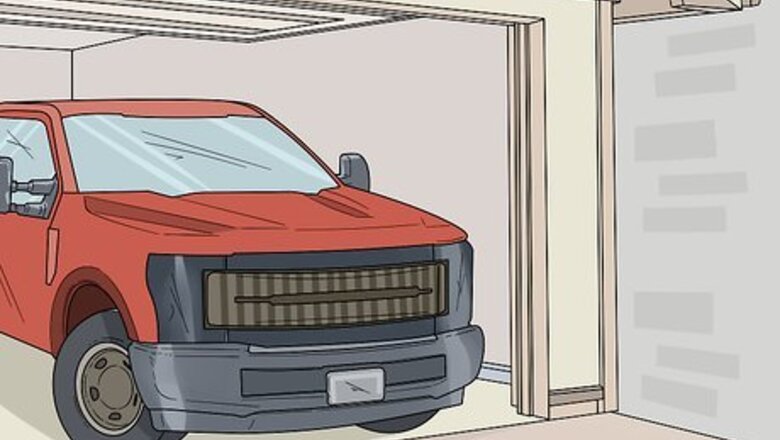
views
Examining the Vehicle

Park the car on a level surface. Move your car to a flat area, like your garage. Don’t make any changes to your vehicle on a sloped area, as this will make the modification process a lot more difficult, and possibly make your adjustments uneven. Since you’re fixing the height of your car, make sure that your vehicle is in a flat, even area. When your car is parked in a level area, you can get a better sense of how high or low your wheel gap is.

Measure the wheel gap between the tire and fender. Take out a measuring tape and place it on the surface of 1 of your front tires. Lift the measuring tape until you reach the edge of the wheel gap, then jot down the total length. Next, go to the opposite tire and take an identical measurement between the tire and fender. These measurements should always be the same. If you’re driving an unbalanced vehicle, you could cause serious long-term damage to your vehicle.
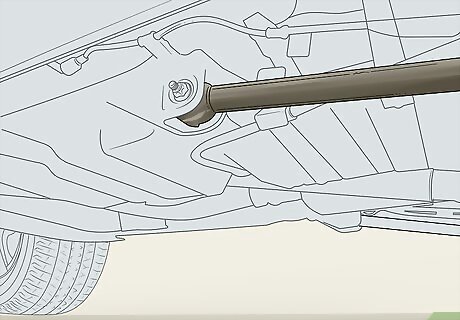
Locate the parallel control arms running beneath the vehicle. Look beneath the car or truck and find a thin pipe that runs lengthwise beneath the vehicle. Go around to the opposite side of the vehicle and peek underneath again to find another pipe that’s parallel to the first. Refer to this pair of pipes as the control arms, which are both connected to the front cross member, or torsion bar. The control arms connect the torsion bar to the wheels. If you’re having difficulty finding your control arms, check your vehicle’s user manual or consult a professional.

Find the torsion bar between both control arms. Glance beneath the vehicle, working your way to the center of the car. Look in the middle of the vehicle’s underbelly to find a thick, rectangular crossmember support that holds the torsion bar, which slides into both control arms. You might see both front and rear torsion bars beneath your vehicle. The front torsion bar is closest to the engine, and it’s what you’ll be adjusting. The front torsion bar has a small key in the center. This key helps the bar stay in place.
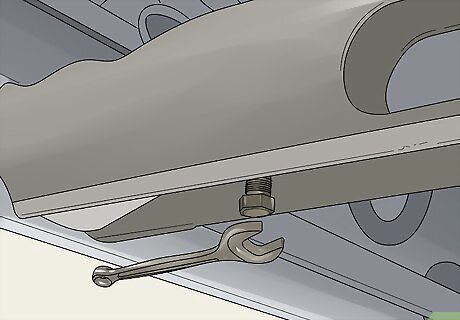
Search for the adjustment bolts on both sides of the torsion bar. Look closely to find a set of bolts on both sides. Use the bolt on the left to adjust the left tire, and tweak the rightmost bolt to make changes to the right tire. Since large, chunky bolts are used to secure the torsion bar into place, you’ll need to use a socket on a ratchet wrench to make your adjustments.
Raising or Lowering the Vehicle
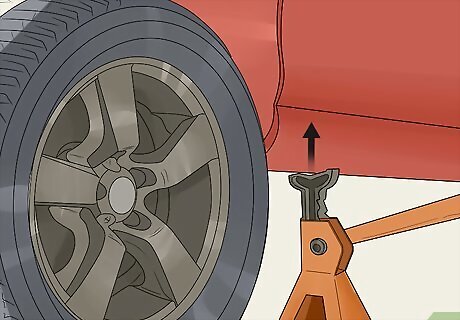
Lift up the car frame with a car jack. Place a car jack beneath the frame of your vehicle and lift your tire off the ground. Check the tire is at least 1 in (2.5 cm) from the ground, so your torsion adjustments don’t put too much pressure on the wheel area. If possible, try using full stand jacks that lift your entire vehicle off the ground. It’s okay if you can only adjust 1 tire at a time. Just make sure that you’ve always jacked up the side of the car that you’re working on. If you don’t jack up your car, you’ll damage the adjuster bolts.

Slide under the vehicle with a ratchet wrench and socket. Work towards the edge of the vehicle, using the control arm to locate the center torsion bar. Find the bolt that’s closest to your position, and place the socket on a ratchet wrench on top of it. Depending on your vehicle, you might need to use a bigger or smaller wrench to complete these adjustments.

Turn the torsion bar bolt clockwise to raise the vehicle. Take your tool and slowly rotate it, working the wrench in a clockwise direction. Don’t worry if you can’t move the wrench in a full circle; instead, turn the bolt 180 degrees twice. Take note of how many times you turn the wrench so you can repeat the same procedure on the opposite side. Don’t make huge adjustments right off the bat. Start off by turning the bolt once or twice, then examine the wheel gap between the tire and rim.

Turn the torsion bar bolt counterclockwise to lower the vehicle. Slide under your raised vehicle while holding a ratchet wrench with a socket attached. Place the socket over the torsion bolt, twisting the tool in a counter-clockwise direction. Twist the wrench in 180-degree increments if you’re unable to make a full rotation.

Remove the car jack and place it along the other side of the car. Once you’re safely out from under the vehicle, take out the car jack and place it beneath the vehicle on the opposite side. Use the jack to lift up the other wheel, checking that the tire is off the ground before you continue. Always use the jack when making any kind of adjustment to your torsion bar, even if it’s minor.
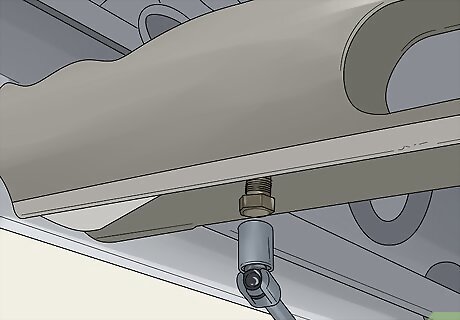
Adjust the torsion bar bolt on the other side of the vehicle in the same way. Arrange the socket on a ratchet wrench on top of the opposite bolt, and begin rotating the tool. Work the wrench in a circle, turning it the same number of times that you turned the bolt on the other side of the vehicle. Make sure to turn the bolt the same way on this side—clockwise to raise the vehicle or counterclockwise to lower it.
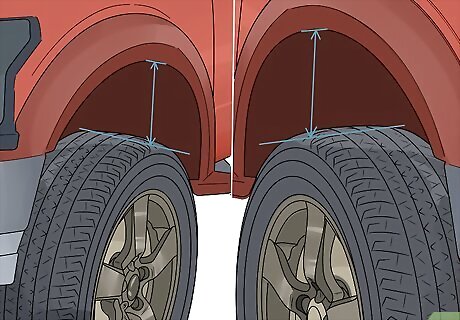
Measure the wheel gap on both tires to ensure that it’s even. Pull yourself out from under the car and take out your measuring tape. Like you did before, place 1 end of the tape on the tire’s surface while measuring the distance between the tire and rim. Check both front tires to confirm that the measurements are the same.Warning: Never drive a vehicle with uneven wheels. If you drive a car or truck with differing wheel gaps, you could permanently damage or break the control arms and/or torsion bar.

Make additional adjustments with your wrench as needed. If there are major height differences between both wheels, go beneath the car and fix any problem areas. Tighten or loosen the bolts as you see fit, pausing to measure in between each adjustment. Don’t test drive your vehicle until these measurements are even. Always use a car jack when making adjustments beneath your vehicle.
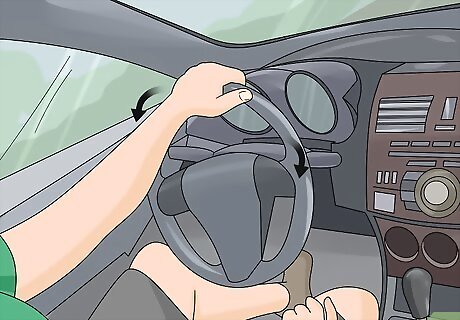
Drive your vehicle a short distance to realign the wheels. Remove the jack from your car, then take the vehicle out for a spin. Cruise down an empty road, turning and swerving your car or truck in small amounts. When you make these quick movements, you’ll help solidify the car’s new height. If your vehicle’s suspension seems off, take it to a repair shop for an inspection. Don’t do any dangerous tricks or movements with your vehicle.












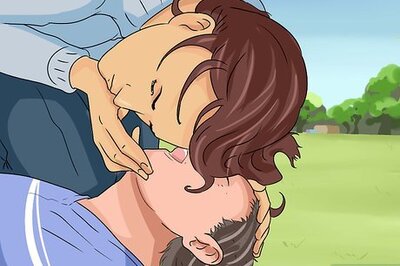



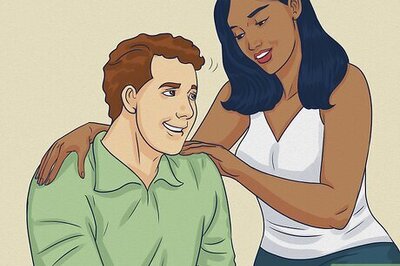



Comments
0 comment